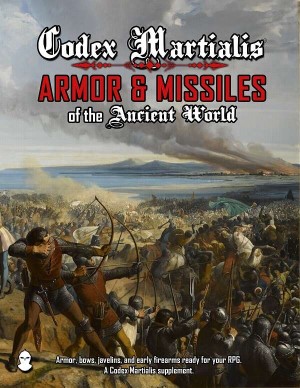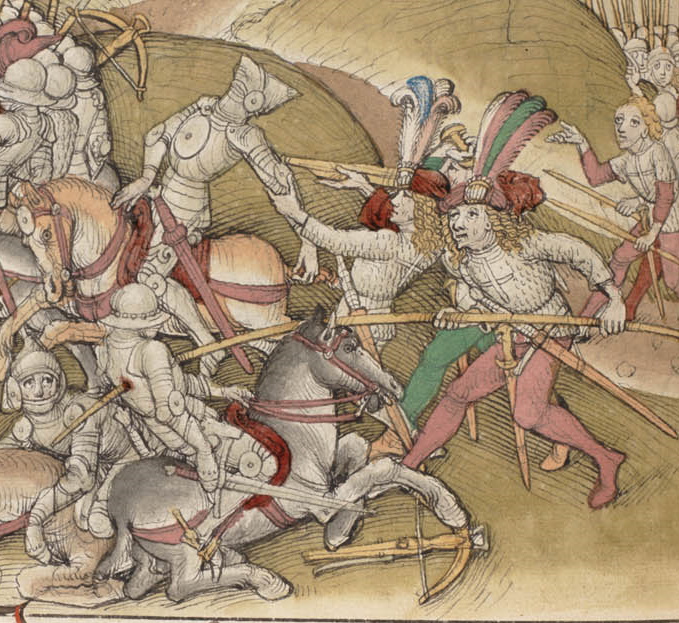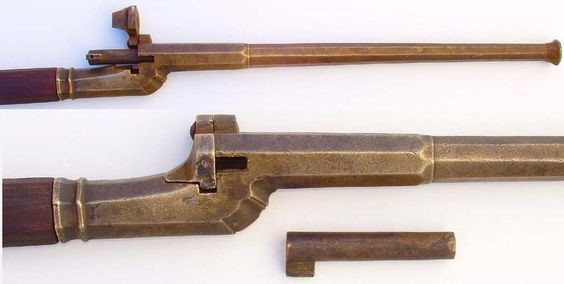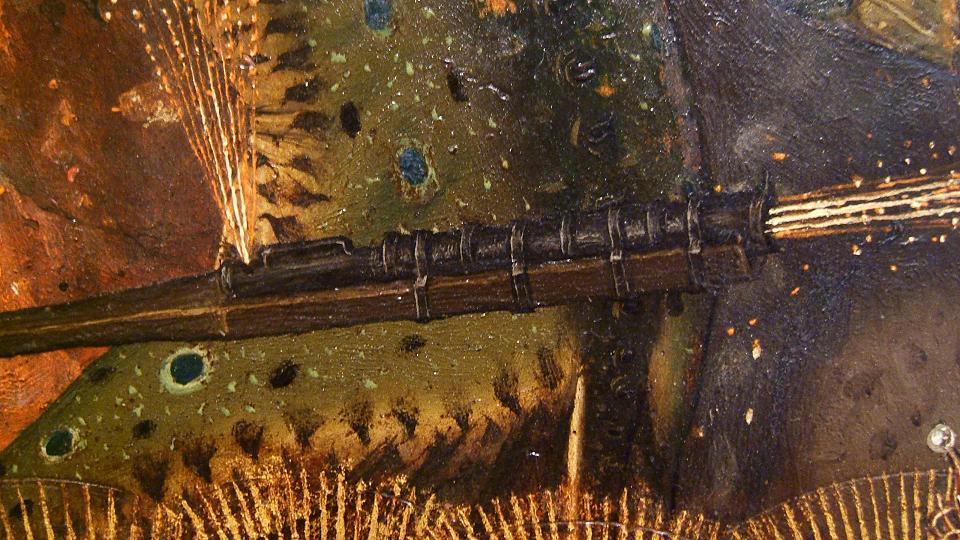
Taking historical parameters and making them into Combat rules
The Graz tests and the NOVA experiment give us results which match the various period military histories and similar records quite closely. Interestingly, those same records were often dismissed by many researchers in the past because they did not match well with modern historical narratives. The hard numbers from the Graz tests (and a few other sources) give us a baseline for how these weapons actually performed, in terms of accuracy, armor penetration, effective range, and wounds. It doesn’t give us everything, but enough to get a basic idea.
The next step is to figure out the level of detail you want, and how realistic you want to be, and what elements of this data can help you tell a better and more engaging story. You have the parameters of the weapons, and you can scale the granularity of this data to suit your game. Because you have a fairly complete model with all the factors, you can do this keeping in all those interconnected factors in mind (which is not the same as saying you have to use them all!). This helps to not break anything when you are trying to adapt real world data to your novel, game or RPG.
In my case, I have an historical RPG game based on DnD. So for our system, we are adapting medieval firearms to that … to those… systems. In the 3.5 SRD the main defining factor of any missile weapon is the “Range Increment”. The way this works is that the first number is the ideal range, at this range, there is no range penalty. Every full range increment after that imposes a -2 penalty, cumulative. Thrown weapons can shoot up to five range increments, projectile weapons can shoot up to ten range increments (but that would be at penalty of -20!). So for example, in the 3.5 SRD a longbow has a range increment of 100’. So that means that at up to 100’ / 30m away the longbow has no penalty, from 101-200’, it’s -2 To Hit, at 201-300’, it’s -4 To Hit, and so on A fairly reasonable system though it requires a little math, and the numbers seem a bit off.
As you would expect, the 5e system is similar but simpler. There are two numbers, the first is the basic range, the second is the max range. If you shoot at targets further away than the first range number you get ‘disadvantage’ on your die roll, meaning roll two dice and take the lower value. That’s all there is to it.
All of this adapts fairly easily to the data we have on firearms. For the Codex we made a slightly modified version of the ‘Range Increment’ idea, but we list two ranges (an increment and a max range) like 5e does. This can then be broken down into six range bands – Melee (0 increments), Close (1), Short (2), Med (3), Long (4), Very Long (5), and Extreme (6). At close range, you gain a +4 To Hit, and a +2 to damage and AP. At short range it’s a +2 To Hit. At Medium Range, no mod. After that it’s -2 To Hit per range band, up to a max of -6.
Next, we structure our range increments for each weapon so that they more closely match the data. Smoothbore firearms are powerful and fairly accurate at short range, and then this tapers off pretty rapidly, in a curve. So for example our Fire Lance is ultra-short ranged, and has a Range Increment of 5’, and a max range of 30’. Because this weapon is a ‘shot’ weapon, expelling flames and multiple projectiles, the damage is 3D4, reflecting the likelihood of being hit by more than one thing. Our Matchlock Arquebus, by contrast, has a Range Increment of 60’ and a max range of 800’. So this means at 180’ / 54m, there is no To Hit modifier, which means about a 50% chance to hit a stationary, man-sized target on a D20. If you factor an average level of experience on the part of the shooter, that 50 /50 mark will move out to Long Range – 300’. This matches the Graz tests.

Contending with armor
Another factor closely associated with early firearms, and frequently mentioned in period sources, is that firearms had some enhanced ability to pierce armor. In our system, armor works as Damage Reduction (DR), so you can either try to go through it or you can try to go around it. Firearms help with the former problem, and to reflect this we give most firearms a substantial armor-piercing bonus, which negates part of the protection of the armor. So that same arquebus has an AP value of 4, meaning if you shot a man wearing an iron cuirass, which absorbs 9 HP of penetrating damage, the bullet negates 4 of those. So if you hit, the damage is more likely to be telling.
Using the hook!
The reason many early firearms had a hook was because they were so typically used by resting them over a wall, the side of a ship, a tree branch, the top of a pavise etc. It was so important that handgunners started carrying shooting rests with them in the 1500s and continued to do so for centuries. This is one of the advantages of a firearm (or a crossbow) over a bow: You can rest it on something and aim as long as you want before shooting, with very little effort. To reflect this in our system we simply grant a Free Dice to your shot when you are able to rest the weapon on a support of some kind. This works in a manner similar to ‘Advantage’ in 5e, you just roll an extra die and take the highest roll.
Reloading
Firearms had advantages, and they also had disadvantages. One of the major drawbacks of these weapons was that while potent in attack, they took a long time to reload. In our system each character has a pool 4 dice to use every turn. A bow can be readied by using one or two of these dice, but firearms require 4 dice or more to reload. This means by the time you shoot, reload, and shoot again with your arquebus, another guy with a bow may have gotten off 4-5 arrows. The gun hits harder, but it comes at a price in terms of prep time.
Special pyrotechnic catastrophes
Another much more serious drawback to firearms was their propensity for accidents. Namely they could start fires and explode catastrophically. Whether or not you want to include this in your game is up to you, but in the real world it was one of the factors which ‘balanced’ firearms compared to other weapons. A bowstring could snap, and a crossbow prod could break and possibly injure somebody, but few things compare to an exploding gun barrel, a runaway fire or a spark getting into a powder magazine. To represent these kinds of grim possibilities we created a mishap table, and how this gets triggered, as well as what ameliorating factors apply, are up to you and depend on how ‘grim’ and real you want your game to be. By default, if you roll a ‘natural 1’, that means a roll for a misfire, and if you get one, then roll again on the gunpowder mishap table. You can also allow a player’s pyrotechnic skill apply to one or both of these rolls.
Using cover and concealment
For missile weapons in general, but especially for firearms which have a higher projectile velocity than most bows, the use of cover is essential. To portray this once again we rely on the ‘Free Dice’. For every 25% of cover, we confer one Free Dice for defense. But to get the Free Dice you also have to spend one from your pool. This quite naturally mimics the very important combat dynamic you may have experienced in a paintball game or perhaps a first person shooter – suppressive fire. You can shoot at someone to get them to expend energy avoiding being shot instead of shooting back. Concealment works the same way as cover, except if you are spotted, the benefit disappears!

A very, very early, and quite elegant bronze breech lock firearm dating back to the 15th Century. With these weapons, multiple breeches could be prepared in advance and kept pre-loaded with powder, ready to rapidly swap out. To see a 3d model / CGI visualization of this breech loading firearm from late 15th Century Nuremberg, click here.


Not all breech loaders were so elegant. These images are from Bartolomé Bermejo “Resurrection and the Descent of Christ” from 1475. In a fascinating echo of the “temptation of Buddha” five centuries earlier, It clearly shows a demon shooting a rather crude, iron ‘hoop and stave’ style breech loading firearm or hand-culverin, and you can see the burning powder coming out of the barrel and the touch hole simultaneously. This style is more like the type of small breech loading cannon which were very common in the 14th Century, particularly for use on ships and boats. By the time this painting was created more sophisticated types were available. Perhaps hell was lacking a bit in the technology race.
Special weapons
For much of the Early Modern period, roughly 1500-1800, firearms remained roughly the same and improved only gradually. But during that period of intense creativity we call the Renaissance many highly innovative designs were created, which for various political and social reasons would not become regular features of firearms until the 19th Century. But in say, 1475 or 1550, there were people who did have them. These include rifled barrels, breech-loading firearms, multi-barreled firearms, and so on. We also have things like grenade launchers (called ‘hand mortars’) and other exotic devices.
These special weapons like breech loaders tend to require unusual levels of skill and expertise to use. They are as far ahead of the technology of their day as a gauss gun or a laser pistol is to us. But they were there… to paraphrase William Gibson again, the future had arrived it was just not evenly distributed. We handle these unique artifacts on an ad-hoc basis but include several of them in our missile weapons book.
Special abilities
The other thing we see in the records, particularly in the military histories, is that there are individuals who stood out in their ability to shoot and hit targets. To mimic these exceptional abilities, we allow characters to acquire special Martial Feats which confer special advantages (usually in the form of Free Dice conferred in different circumstances). For example, The Patient Shot means if you, as an experienced marksman, spend at least a turn aiming before shooting, you gain another Free Dice (cumulative with all others) for your shot, thus enhancing the likelihood of a hit, and of causing extra damage with an Artful Shot or a Critical Hit.
And That’s All Folks!
I hope this little trip down the rabbit hole of medieval firearms was entertaining and useful to you as a gamer, game designer, author, historical fencer, re-enactor, enthusiast of medieval history or military history, or just an ordinary person equipped with curiosity. For more about all the history stuff I covered in this article, including a thorough bibliography of sources, check out our Codex Guide to the Medieval Baltic Volume I and Volume II. For more on our game rules, check out Codex Martialis Core Rules and Codex Martialis Armor and Missile Weapons. You can also always find us on our forum at Codex Integrum, on FB and Instagram, and on our Discord. If you have questions, comments, or corrections for this article, we would love to hear from you!
